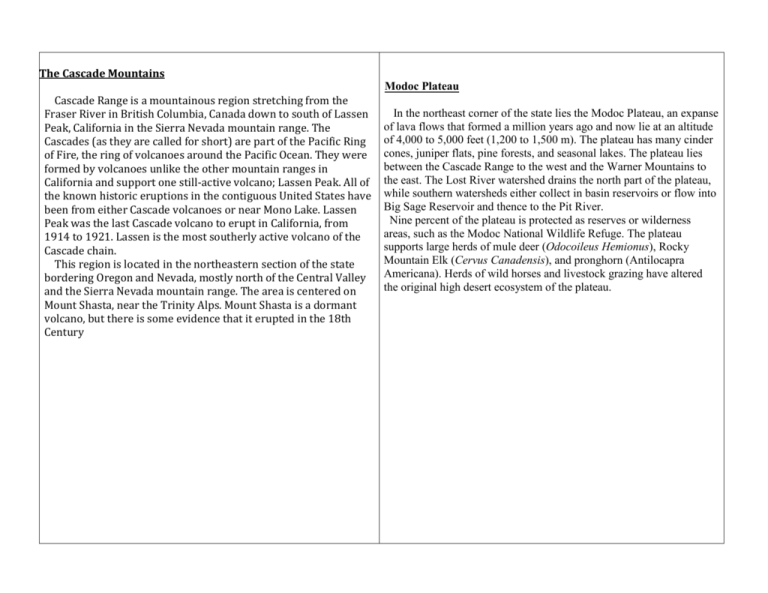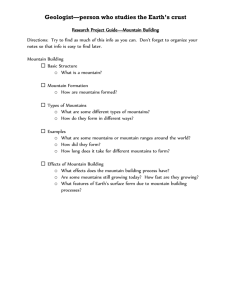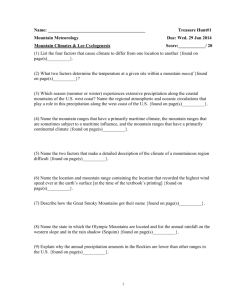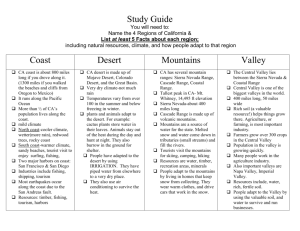File
advertisement

The Cascade Mountains Cascade Range is a mountainous region stretching from the Fraser River in British Columbia, Canada down to south of Lassen Peak, California in the Sierra Nevada mountain range. The Cascades (as they are called for short) are part of the Pacific Ring of Fire, the ring of volcanoes around the Pacific Ocean. They were formed by volcanoes unlike the other mountain ranges in California and support one still-active volcano; Lassen Peak. All of the known historic eruptions in the contiguous United States have been from either Cascade volcanoes or near Mono Lake. Lassen Peak was the last Cascade volcano to erupt in California, from 1914 to 1921. Lassen is the most southerly active volcano of the Cascade chain. This region is located in the northeastern section of the state bordering Oregon and Nevada, mostly north of the Central Valley and the Sierra Nevada mountain range. The area is centered on Mount Shasta, near the Trinity Alps. Mount Shasta is a dormant volcano, but there is some evidence that it erupted in the 18th Century Modoc Plateau In the northeast corner of the state lies the Modoc Plateau, an expanse of lava flows that formed a million years ago and now lie at an altitude of 4,000 to 5,000 feet (1,200 to 1,500 m). The plateau has many cinder cones, juniper flats, pine forests, and seasonal lakes. The plateau lies between the Cascade Range to the west and the Warner Mountains to the east. The Lost River watershed drains the north part of the plateau, while southern watersheds either collect in basin reservoirs or flow into Big Sage Reservoir and thence to the Pit River. Nine percent of the plateau is protected as reserves or wilderness areas, such as the Modoc National Wildlife Refuge. The plateau supports large herds of mule deer (Odocoileus Hemionus), Rocky Mountain Elk (Cervus Canadensis), and pronghorn (Antilocapra Americana). Herds of wild horses and livestock grazing have altered the original high desert ecosystem of the plateau. Klamath Mountains The Klamath Mountains are a mountain range in northwest California and southwest Oregon, the highest peak being Thompson Peak (2,744 m / 9,002 ft) in Trinity County, California. They have a very varied geology, with substantial areas of serpentine and marble, and a climate characterized by moderately cold winters with very heavy snowfall, and warm very dry summers with limited rainfall. They consist of several small, forested ridges that are higher and steeper than the coastal ranges farther south. These ridges are separated by deep canyons and valleys. As a consequence of the geology, they have a unique flora including several endemic or near-endemic species, such as Lawson's Cypress (Chamaecyparis lawsoniana) and Foxtail Pine (Pinus balfouriana). Brewer's Spruce (Picea breweriana) and Kalmiopsis (Kalmiopsis leachiana) are relict species, remaining since the last ice age. Peninsular Ranges The southernmost mountains of California are the Peninsular Ranges, which are East of San Diego and continue into Baja California (Mexico) in the Sierra San Pedro Martir. The Peninsular Ranges contain the Laguna Mountains, the San Jacinto Mountains, the Santa Rosa Mountains, the Santa Ana Mountains and the Palomar Mountain Range, notable for its famous Palomar observatory. San Jacinto Peak's eastern shoulder has a cable tram that runs from the desert floor to nearly the top of the mountain where riders can set off hiking or go cross-country skiing. Sierra Nevada The Sierra Nevada range, mostly within California and barely extending into Nevada, rises sharply from the arid basin and range on the east and slopes gently toward the Central Valley of California on the west. The Sierra Nevada mountain range runs about 430 miles from north to south and forming a giant wall rising to over 14,000 feet. Vegetation at lower elevations is dominated by lodgepole pine on the east and ponderosa pine on the west, with fir, spruce, and alpine tundra at higher elevations. Southern Sierra started to form in the Triassic period when an island arc collided with the West coast of North America and raised a set of mountains. At roughly the same time, the oceanic plate started to dive beneath the North American plate. Magma from the melting oceanic plate rose in plumes (plutons) from 115 million to 87 million years ago deep underground, their combined mass forming what is called the Sierra Nevada batholith. By 65 million years ago, the proto-Sierra Nevada was worn down to a range of rolling low mountains, a few thousand feet high. Twenty million years ago, crustal extension associated with the Basin and Range Province caused extensive volcanism in the Sierra. About 4 million years ago, the Sierra Nevada started to form and tilt to the west. Rivers started cutting deep canyons on both sides of the range. The Earth's climate cooled, and ice ages started about 2.5 million years ago. Glaciers carved out characteristic U-shaped canyons throughout the Sierra. The combination of river and glacier erosion exposed the uppermost portions of the plutons emplaced millions of years before, leaving only a remnant of metamorphic rock on top of some Sierra peaks. Basin and Range The Basin and Range is a large physiographic area covering most of Nevada, part of eastern California, western Utah, and southeast Idaho. It lies in the rainshadow of the Sierra Nevada, south of the Columbia Plateau and north of the Mohave Desert, and is a mosaic of xeric basins, scattered mountains, and salt flats. It is hotter and contains more and higher mountains than the Columbia Plateau, with more perennial streams and ponderosa pine forest at the higher elevations. Compared to the Mojave Desert, it is not as hot and is more dominated by shrubland and less by grassland. Columbia Plateau is an arid sagebrush steppe and grassland surrounded on the north, west, and east by moister, predominantly forested, mountainous ecological regions. It is an oddly shaped physiographic area that covers portions of Washington, Oregon, Idaho, Nevada, and a small piece of northeast California. It consists of arid tablelands, intermontane basins, dissected lava plains, and widely scattered low mountains. There is a more subtle transition to the Basin and Range to the south in which hotter lowlands are dissected by isolated mountain ranges Transverse Range (The Los Angeles Ranges) Great Valley (San Joaquin Valley) Southern California is separated from the rest of the state by the east-west trending Transverse Ranges, including the Tehachapi, which separate the Central Valley from the Mojave Desert. The Peninsular Ranges located to the south cover the southwestern tip of the state. Urban Southern California intersperses the valleys between the Santa Susana Mountains, Santa Monica Mountains and San Gabriel Mountains, which range from the Pacific Coast, eastward over 100 miles (160 km), to the San Bernardino Mountains, north of San Bernardino. The highest point of the range is Mount San Gorgonio at 11,499 feet (3,505 m). The San Gabriel Mountains have Mount Wilson observatory, where the redshift was discovered in the 1920s. California's geography is largely defined by its central feature — the Central Valley, a huge, fertile valley between the coastal mountain ranges and the Sierra Nevada. The northern part of the Central Valley is called the Sacramento Valley, after its main river, and the southern part is called the San Joaquin Valley after its main river. The whole Central Valley is watered by mountain-fed rivers (notably the San Joaquin, Kings, and Sacramento) that drain to the San Francisco Bay system. The rivers are sufficiently large and deep that several inland cities, notably Stockton, and Sacramento are seaports. The Transverse Ranges include a series of east–west trending mountain ranges that extend from Point Conception at the western tip of Santa Barbara County, eastward (and a bit south) to the east end of the San Jacinto Mountains in western Riverside County. The Santa Ynez Mountains make up the westernmost ranges, extending from Point Conception to the Ventura River just west-northwest of Ojai, in Ventura County. Pine Mountain Ridge, Nordhoff Ridge–Topatopa Mountains, Rincon Peak–Red Mountain, Sulphur Mountain, Santa Paula Ridge, South Mountain–Oat Mountain–Santa Susana Mountains, Simi Hills, Conejo Mountains–Santa Monica Mountains are all part of the Western Transverse Ranges, in Ventura and western Los Angeles Counties. The Liebre Mountains occupy the northwest corner of Los Angeles County, and represent a northwestern extension of the San Gabriel Mountains, both on the Pacific Plate side of the San Andreas Fault. The fault divides the San Gabriel Mountains from the San Bernardino Mountains further to the east in San Bernardino County. It is possible to surf in the Pacific Ocean and ski on a mountain during the same winter day in Southern California. The southern tip of the valley has interior drainage and thus is not technically part of the valley at all. Tulare Lake, once 570 square miles (1,476 square kilometers) and now dry and covered with agricultural fields, once filled much of the area. This is a fertile area that extends 500 miles from the northwest to the southeast. Farmland is located in this region. The San Joaquin and the Sacramento, two of the state's largest river systems are located in the Central Valley. To the east of the Central Valley is the Sierra Nevada region, a 400mile long area of massive granite rock. The highest point in the continental United States, Mt. Whitney, with an elevation of 14,495 feet, is located here. Mt. Shasta and Mt. Lassen, two volcanic peaks, lie to the north of the Sierra Nevada. They are part of the Cascade Mountains. The Central and Southern California Coast and Valleys covers the central and southern coast of California, including the San Francisco Bay and extending to the Mexican border. In the interior it includes the Central Valley and foothills of the Sierra Nevada. Chaparral is the climax vegetation of areas characterized by a Mediterranean climate. Various oaks and other evergreen trees dominate many of the foothills. The Central Valley was a wetlandgrassland complex dissected by riparian strips. This is a diverse area with a high degree of endemism. Coastal Ranges Great Basin Region These Ranges in the north reach inland 20 to 30 miles extend from the Klamath Mountains in the north south to Santa Barbara. The Diablo and Santa Cruz Mountains are located in the Coastal Ranges. Napa Valley separates these ranges. The legendary Redwoods and the San Andreas Fault are located in the Coastal Ranges. The San Andreas Fault enters California from the Pacific Ocean near Port Arena and extends southeast into the state. Earthquakes are caused by movement of the earth's crust along this fault The Great Basin Region is part of a larger area that extends into Nevada and Oregon. In northern California, it is a lava plateau. To the south, it is an area of wastelands that include the Mojave Desert and the Colorado Desert. North America's lowest point, Death Valley, 282 feet below sea level, is located in the Great Basin. Southern Pacific Rainforests extends from the Pacific coastline of Washington and Oregon inland to the crest of the Cascade Mountains. It ends arbitrarily at the Canadian border, and also includes the coastal ranges of northwestern California. Save for coastal estuaries and some inland drier valleys (the Willamette and the Puget Trough), the natural vegetation is coniferous forest. There are six coniferous forest types, defined by elevation and latitude, including the coastal Sitka spruce zone, lowelevation western hemlock/western red cedar, mid-elevation Pacific silver fir zone, subalpine mountain hemlock, a mixedconifer zone in the Klamath/Siskiyou Mountains, and the redwood forest of northwest California Colorado Desert To the east of the peninsular ranges lie the Colorado and Sonoran Deserts, which extend into Arizona and Mexico. The ground elevation is generally lower and in some areas was compressed downward, therefore the eastern Coachella and Imperial Valleys north of the U.S.-Mexican border are below sea level, the lowest community in the U.S. is Calipatria, California at 160 feet (49 m) below sea level. The Sonoran Desert receives a low and unevenly distributed amount of precipitation over extensive plains and isolated mountains surrounding the northern end of the Gulf of California. In the United States it is centered in southwest Arizona and southeast California and extends south through most of Baja California Norte and Sur and the western half of the state of Sonora. Vegetation is sparse and differs from other American deserts by a greater dominance of trees, including arborescent cacti such as the saguaro. Creosote is a common and widely distributed shrub. Mojave Desert In the "Great American Desert" of the Southwest, the Mohave lies between and is intermediate in nature between the Great Basin to the north and the Sonoran Desert to the south and east. It is mostly in southeast California but extends also into southern Nevada, northwest Arizona, a very small part of southwest Utah, and lies in the rain shadow of the Southern California Ranges to the west. Its most prominent features are broad, sparsely vegetated plains. However, it also includes dry lakes, sharply rising buttes and relatively small mountain ranges, and its eastern portion is cut through by the Colorado River. It is generally a higher elevation desert than the Sonoran, although elevation descends to -300 m in Death Valley. Low precipitation, most falling in winter, with low winter and high summer temperatures are characteristic. The Great Basin Region is part of a larger area that extends into Nevada and Oregon. In northern California, it is a lava plateau. To the south, it is an area of wastelands that include the Mojave Desert and the Colorado Desert. North America's lowest point, Death Valley, 282 feet below sea level, is located in the Great Basin.





